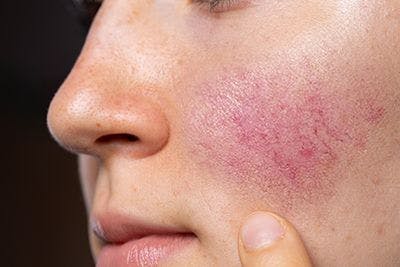- Acne
- Actinic Keratosis
- Aesthetics
- Alopecia
- Atopic Dermatitis
- Buy-and-Bill
- COVID-19
- Case-Based Roundtable
- Chronic Hand Eczema
- Chronic Spontaneous Urticaria
- Drug Watch
- Eczema
- General Dermatology
- Hidradenitis Suppurativa
- Melasma
- NP and PA
- Pediatric Dermatology
- Pigmentary Disorders
- Practice Management
- Precision Medicine and Biologics
- Prurigo Nodularis
- Psoriasis
- Psoriatic Arthritis
- Rare Disease
- Rosacea
- Skin Cancer
- Vitiligo
- Wound Care
Publication
Article
Dermatology Times
Pretreatment punch technique guides safe injection
Author(s):
A series of needle punctures down to the periosteum along glabellar line(s) allows clinicians to assess for the presence of the supratrochlear artery and/or its branches prior to filler injection.
Approach minimizes risk of necrosis when treating glabellar lines
Soft tissue augmentation with a hyaluronic acid filler can be an effective technique for improving the appearance of deep vertical glabellar rhytids. Relative to other facial sites, however, filler injections into the glabellar region carry a higher risk of necrosis from inadvertent vascular compression, obstruction or direct injury.
In a recently published article, Pinar Özdemir Çetinkaya, M.D., and colleagues described their technique for maximizing safety using a filler to correct glabellar rhytids and reported outcomes with its use in a retrospective study including 50 patients.1
To guide the filler injections, their approach utilizes a needle punching technique that assesses for the presence of the supratrochlear artery and/or its branches. Deep placement of the filler onto the periosteum further minimizes risk and makes the procedure ideal for correcting moderate to deep glabellar wrinkles, said Dr. Özdemir Çetinkaya, department of dermatology and venereology, Nazillili State Hospital, Aydin, Turkey.
“There can be anatomical variations in the vascular network in the glabellar region. A three-point puncture technique allows the practitioner to estimate the course of the underlying vessels and deliver the filler accordingly,” she explains.
“Although the size of our study population may be too small to determine the true prevalence of a rare severe complication, we encountered no cases of skin necrosis or visual impairment among our patients, and we achieved a very high rate of patient satisfaction.”
The punctures are made at three equidistantly spaced sites along the glabellar line(s) using a 23-gauge punching needle that is inserted perpendicularly through the skin, advanced until it meets the periosteum of the frontal bone, and then withdrawn. Then, the amount of bleeding is assessed.
“If the bleeding is punctual, slow and minimal, it is assumed that it originates from the capillaries in the dermal papillae, and thus, neither the supratrochlear artery nor any of its branches lies below,” Dr. Özdemir Çetinkaya says.
“If the bleeding is excessive, fast, and hard to stop, it is assumed that the needle entered into the lumen of the supratrochlear artery or one of its branches. Once the bleeding is controlled through pressure application, an alternate site located 1-2 mm above or below is tested for safety using the puncture technique.”
Standard recommendations for safe filler injection are also followed. Filler delivery for moderate-to-deep glabellar rhytids is performed using a 25-gauge, 50-mm cannula that is inserted perpendicularly to the periosteum of the bone. Aspiration is performed prior to injecting the filler to verify that the instrument has not entered into any vessel. Then, the hyaluronic acid is delivered using small droplets (0.05 to 0.2 mL) and with a slow flow rate while patients are questioned about the presence of any pain.
In the retrospective study reported by Dr. Özdemir Çetinkaya and colleagues, cross-linked hyaluronic acid 20 mg/mL with 0.3% lidocaine (Juvéderm VOLUMA XC) was used as the filler material. Other hyaluronic acid products fillers are also suitable, Dr. Özdemir Çetinkaya says.
The 50 patients included in the review had moderate-to-severe glabellar rhytids (grade 3 or higher on the Rao-Goldman 5-point wrinkle scale) – 28 patients (56%) had moderately deep wrinkles (Rao-Goldman score of 3), 17 patients (34%) had deep wrinkles with well-defined edges (Rao-Goldman score of 4), and two patients (10%) had very deep wrinkles with redundant folds (Rao-Goldman score of 5). The cohort included 39 females and 11 males with a mean age of approximately 40 years (range 25 to 50 years).
All patients underwent neurotoxin injection in the glabellar complex two weeks prior to the filler procedure. At two weeks after the filler injection, patients returned for outcome assessment and received a touch-up, if needed, with injection of the filler into the subdermal plane from a single distant entry point. Eight patients (16%) underwent a touch-up.
Outcomes were evaluated at two weeks after the first injection. The results showed that all patients achieved a one- to two-grade improvement from baseline in the Rao-Goldman score. Forty-one patients (82%) achieved complete effacement of their glabellar wrinkles, eight patients (16%) had shallow wrinkles, and one patient (2%) had moderately deep wrinkles.
“The latter patient had a Rao-Goldman score of five at baseline, improved to grade three, and received a touch-up,” Dr. Dr Özdemir Çetinkaya tells Dermatology Times.
Patient satisfaction was good. No patients were dissatisfied, and 45 patients (90%) said they were satisfied or extremely satisfied with their treatment.
Eight patients developed procedure-related complications. These included bruising (4%), erythema and edema (10%) and a local infection (2%). All of the events were mild, managed with minor interventions, and resolved within three to seven days.
Disclosure:
Dr Özdemir Çetinkaya has no relevant financial interests to disclose.
References:
1 Sahan A, et al. J Cosmet Dermatol. 2020;19(6):1311-1315

Newsletter
Like what you’re reading? Subscribe to Dermatology Times for weekly updates on therapies, innovations, and real-world practice tips.





























